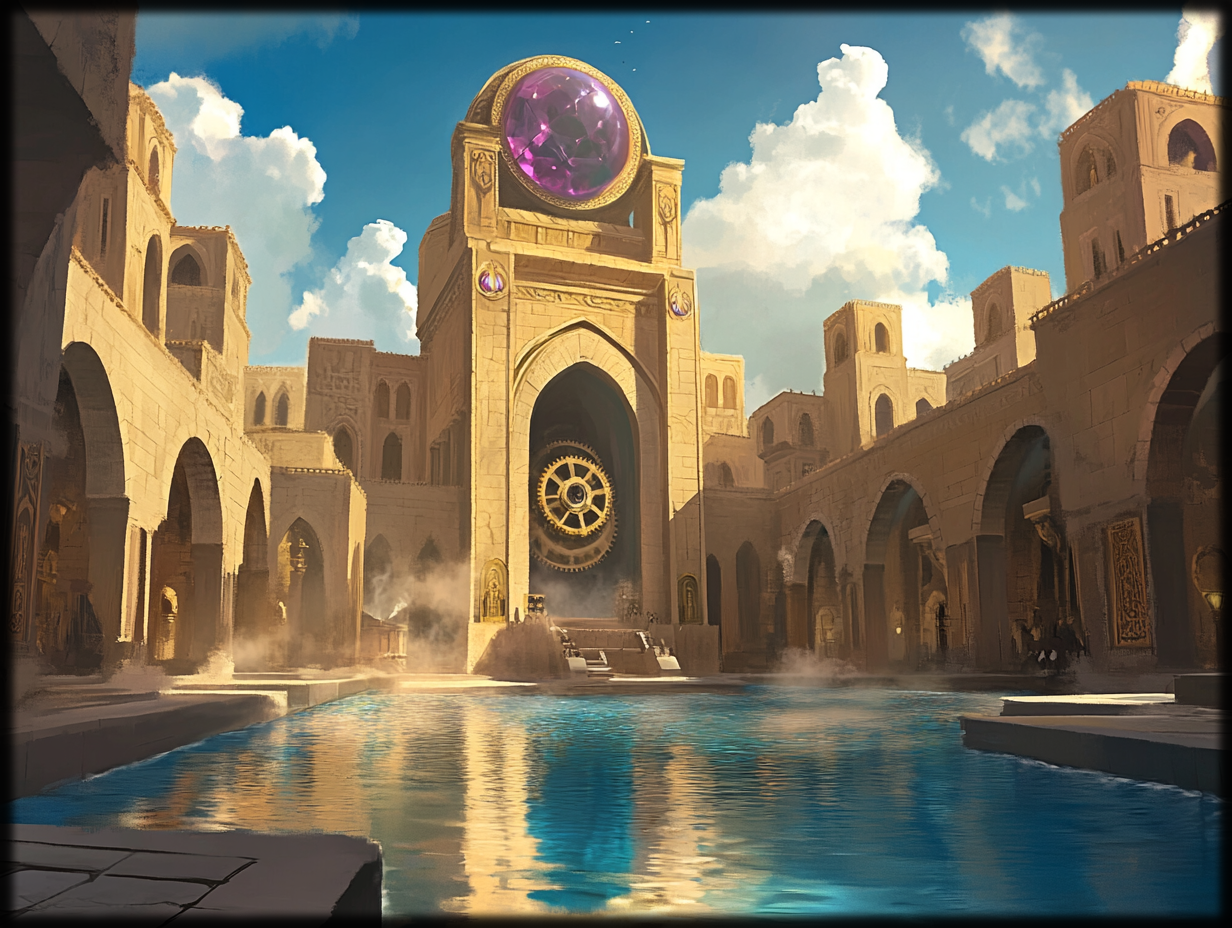Bennain Guildhall
I write this today, with the knowledge of yesterday
Look past yourself and see the bigger picture
Think of all the ones before who never got a say
And the ones who came out as the false victors
~Cuannur
I write this today, with the knowledge of yesterday
Look past yourself and see the bigger picture
Think of all the ones before who never got a say
And the ones who came out as the false victors
~Cuannur[justifyThe Bennain Guildhall was named in perpetuity for its founder, Cuannur Bennain, that famous, impetuous, and occasionally infamous Artificer whose discontent with the slow-turning wheels of academic tradition became one of the levers to move a city into the sky. Yet, for all the laurels heaped at his feet, Bennain found the formal strictures of pure scholarship intolerable—too many old men, he said, and too many old ideas embalmed in gold leaf. Thus, after a particularly stormy convocation, he stormed out over the Min Althalatha—the Plaza of Three—and there, at the center of Warda District, began to build a counter-cathedral dedicated not to old knowledge, but to the furious making of things new.
Bennain’s Guildhall had become, in the years since, both a living testament to his philosophy and a monument to the city’s inexhaustible appetite for invention. Its spires were composed not of stone but of layered brass filigree, etched with equations and threaded with stained glass cogwheels. The entrance was flanked by pillars that turned gently in the breeze, each rotation marking a different hour of the day, so that a visitor arriving at dawn would hear the honeyed chime of “First Bell,” while those who lingered after dusk would witness the slow, melancholy tolling of the “Final Circuit.” The Guildhall’s vast atrium was a gathering place for artisans, mechanics, kinetic sculptors, and clockwrights—their eyes bright with vision and ambition, their hands stained with oil and volatile dye. Here, the air forever vibrated with the click and whirr of fresh prototypes: some destined for the city’s streets, others for the prestigious Great Games of Makira, and still more for the bottomless curiosity of the Guild’s own archives.
The rivalry between the Bennain Guildhall and its collegiate neighbors was a subject of both high drama and low comedy. The Guildhall’s members, who preferred the term “Artisans” to the more academic “Artificers,” regarded the nearby Desert Rose University as little more than a museum for stuffy geniuses, and the Taqadum School of Technomancy as a hothouse for theoretical eccentrics—a place where, as one Artisan put it, “the only thing that ever gets built are arguments.” For their part, the University faculty accused the Guildhall of reckless technophilia and a dangerous disregard for the finer points of magical law. On days when the Min Althalatha was especially crowded—commemorations, market festivals, or the solstice parades—the debates would spill into the open, with rival apprentices staging impromptu duels of wit and gadgetry. To the amusement of the local vendors, these contests sometimes escalated into small-scale skirmishes: confetti-cannons versus paintball golems, or lightning-cast dice games whose stakes were measured in hours of extra laboratory labor.
Yet even the most trenchant critics could not deny the profound impact of Bennain’s Guild on the daily life of Shal’Azura. The Guildhall’s signature creations, the yahmil—automated carriers of goods—had revolutionized commerce in the sky city, their articulated arms and concertina legs traversing the winding bridges with a grace that made the old donkey-pulled carts seem prehistoric. The more advanced ywsail, passenger-bound automata, had all but replaced the traditional coaches and sedan chairs. The Guild’s street-level workshops were open day and night, always lit by the cold fire of aetherlamps, inviting all comers to witness the ongoing spectacle of invention. Even the children—the children most of all—idolized the Artisans, collecting miniature wind-up figurines of the Guild’s most famous models, naming them after legendary apprentices and painting them in the colors of their favorite district.
The Guild’s inner sanctum was accessible only to full members, and it was there, behind walls of soundproofed crystal and woven starsilk mesh, that the grandest projects took shape. Some of these inventions were pragmatic in the extreme: self-cleaning aqueduct filters, or weather-baffling canopies for the city’s hanging gardens. Others approached the metaphysical: memory recorders that captured the last dreams of the dying, or mechanical familiars capable of learning their owner’s deepest secrets. The Guild’s own leadership, the Golden Artisans, convened weekly in a domed chamber whose acoustics allowed anyone to whisper and be heard perfectly from across the room—a design, it was rumored, meant to discourage both shouting and secrets.
From the vantage point of the Guildhall’s uppermost terrace, one could look down on the entire Warda District, as well as the rival institutions across the Plaza of Three. At dusk, when the city’s cloud-shadowed streets gleamed with a thousand artificial suns, it was possible to imagine that Shal’Azura itself was little more than a grand contraption, each of its neighborhoods a gear or spring in a mechanism beyond the ken of any single mind. For the Bennain Guild and its adversaries alike, the real contest was not for the present, but for the shape of that future machine.

Related Ranks & Titles
Controlled Territories
Notable Members



Found 1